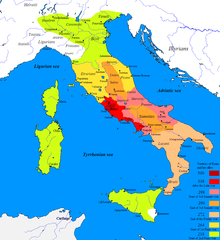| Millennium: | 1st millennium BC |
|---|---|
| Centuries: | |
| Decades: | |
| Years: |
| 290 BC by topic |
| Politics |
|---|
| Categories |
| Gregorian calendar | 290 BC CCXC BC |
| Ab urbe condita | 464 |
| Ancient Egypt era | XXXIII dynasty, 34 |
| - Pharaoh | Ptolemy I Soter, 34 |
| Ancient Greek era | 122nd Olympiad, year 3 |
| Assyrian calendar | 4461 |
| Balinese saka calendar | N/A |
| Bengali calendar | −882 |
| Berber calendar | 661 |
| Buddhist calendar | 255 |
| Burmese calendar | −927 |
| Byzantine calendar | 5219–5220 |
| Chinese calendar | 庚午年 (Metal Horse) 2408 or 2201 — to — 辛未年 (Metal Goat) 2409 or 2202 |
| Coptic calendar | −573 – −572 |
| Discordian calendar | 877 |
| Ethiopian calendar | −297 – −296 |
| Hebrew calendar | 3471–3472 |
| Hindu calendars | |
| - Vikram Samvat | −233 – −232 |
| - Shaka Samvat | N/A |
| - Kali Yuga | 2811–2812 |
| Holocene calendar | 9711 |
| Iranian calendar | 911 BP – 910 BP |
| Islamic calendar | 939 BH – 938 BH |
| Javanese calendar | N/A |
| Julian calendar | N/A |
| Korean calendar | 2044 |
| Minguo calendar | 2201 before ROC 民前2201年 |
| Nanakshahi calendar | −1757 |
| Seleucid era | 22/23 AG |
| Thai solar calendar | 253–254 |
| Tibetan calendar | 阳金马年 (male Iron-Horse) −163 or −544 or −1316 — to — 阴金羊年 (female Iron-Goat) −162 or −543 or −1315 |

Year 290 BC was a year of the pre-Julian Roman calendar. At the time it was known as the Year of the Consulship of Rufinus and Dentatus (or, less frequently, year 464 Ab urbe condita). The denomination 290 BC for this year has been used since the early medieval period, when the Anno Domini calendar era became the prevalent method in Europe for naming years.